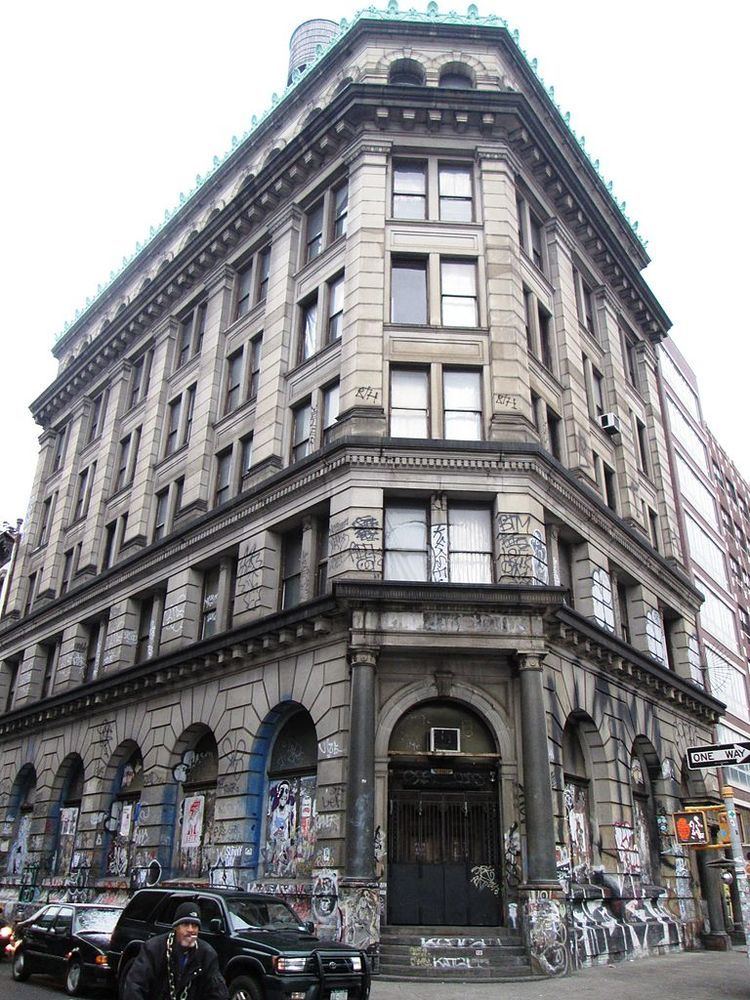 | ||
Germania Bank building is a former bank location at 190 Bowery, on the northwest corner of the intersection with Spring Street in Manhattan. Built in 1898–99 and designed in the Renaissance Revival style by architect Robert Maynicke, it was the third home of the Germania Bank, which was established in 1869 by a group of local businessmen of German extraction. Currently a private residence, the building was designated a New York City landmark on March 29, 2005.
Contents
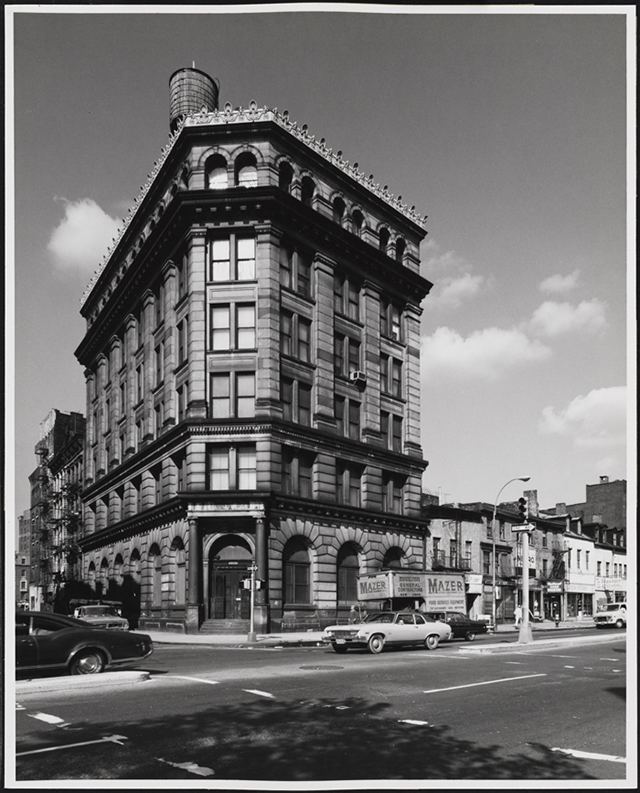
Description
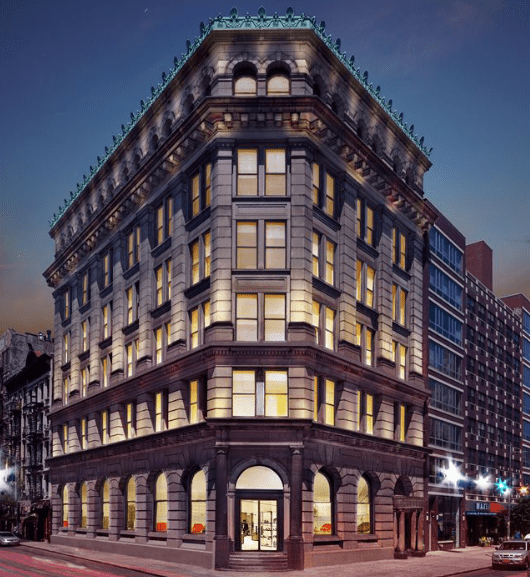
The six-story building’s two main facades, which are clad in granite, consist of a series of bays that are identical above the first story. There are three bays facing the Bowery, one angled bay at the chamfered corner, and six bays along Spring Street. Horizontal divisions are provided by a cornice with modillions above the first story, a denticulated crown molding above the second story, and a heavy cornice above the fifth story supported by large blocks and featuring a series of cyma moldings, fillets, and ovolos. The facades are surmounted by an elaborate copper cheneau decorated with anthemia, rosettes, and waves.

The rusticated base contains the building’s primary and secondary entrances, and large, round-arched fenestration that lit the main public spaces of the bank. The main entryway, located at the angled corner bay, is a monumental, projecting portico. The portico, which contains a flight of bluestone steps leading to the main doorway, features freestanding Tuscan columns, decorated with rosettes and egg-and-dart moldings, supporting a molded entablature. The paneled wood entry doors feature a carved enframent and are flanked by paneled pilasters and are topped by an arched transom light (now sealed by what appears to be a Plexiglas panel) with a molded architrave and foliated keystone and flanking, paneled spandrels. It is protected by historic, elaborate wrought-iron gates. The round-arched, first-story windows are deeply set and the façade rustication is continued on the returns.
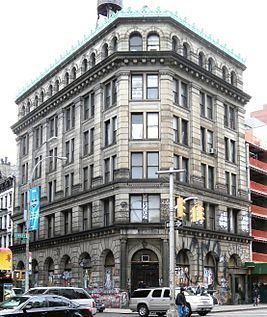
The sills are slightly recessed and sit above concave stone panels. Voussoirs surround the arches. The sash and transoms, which are presently sealed with what appear to be Plexiglas panels, look to be historic one-over-one wood sash. They are separated by carved wood mullions and transom bars. The secondary entryway, located at street level facing the Bowery, features a granite portico with freestanding Tuscan columns decorated with rosettes and egg-and-dart moldings, supporting an entablature decorated with triglyphs and guttae. The entryway is filled with paneled, wood-and-glass doors19 covered with elaborate wrought-iron gates.
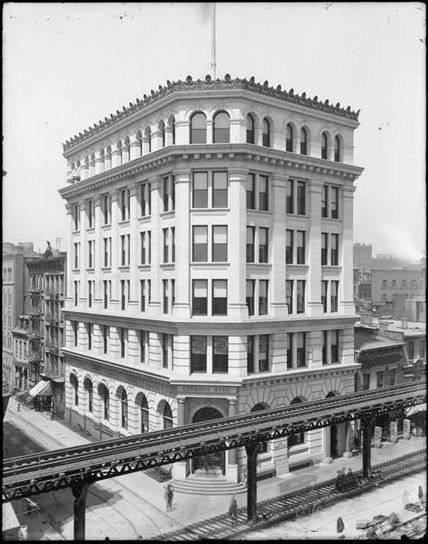
The upper stories feature banded stonework, paired fenestration from the second through the fifth floors, and projecting, multi-story piers from the third through the fifth floors on molded bases and carved caps with egg-and-dart moldings. Paneled spandrels separate the third-through the fifth-floor fenestration, which contains one-over-one wood or steel sash. The sixth story displays pairs of round-arched windows with voussoirs that spring from molded bands and projecting keystones. The one-over-one sash appears to be made of wood.
The brick north elevation contains what appear to be historic, one-over-one wood sash with historic steel shutters. The west elevation consists of a plain brick wall. The roof contains brick parapet walls, bulkheads, and chimney, non-historic wood and metal fences, and a wood water tank on a steel-framed base.
"Little Germany"
By 1840, more than 24,000 German immigrants and their descendents were living in New York City. Their numbers increased dramatically over the next two decades, resulting in the development of the area along and to the east of the Bowery above Division Street as a German neighborhood called Kleindeutschland, or Little Germany.
The neighborhood became the major German-American center in the United States during the second half of the nineteenth century. German immigrants contributed greatly to New York City by establishing churches, synagogues, and other cultural organizations, as well as creating their own banking, savings, and loan institutions, such as the Germania Bank. They also opened architectural firms and construction companies. Architect Robert Maynicke, who was of German birth, attended Cooper Union, about ten blocks to the north of this building, and worked for the noted architect George B. Post before co-founding the firm Maynicke & Franke in 1895. The Germania Bank building is considered to be one of his most important designs. Marc Eidlitz, whose construction company built the bank, was also of German descent.
The granite and brick building features rusticated stonework, a chamfered corner with an arched entry flanked by Tuscan columns, and multi-story pilasters. The ground floor features large arched openings with voussoirs surmounted a massive denticulated cornice. A similar cornice terminates the fifth story. The top story features paired arched openings also surrounded with voussoirs and concludes in an elaborate copper cheneau. The building’s facades are remarkably intact.
Founding and construction
The Germania Bank of the City of New York was established in 1869 at 185 Bowery by a group of local businessmen at a time when the Bowery was occupied by many stores that were owned by German immigrants. The first president of the bank was Christian Schwarzwaelder, a resident of West 36th Street, who owned a furniture store at 9 East Broadway. The vice-president, Joseph Kuntz, owned a brewery at 225 East Houston Street and lived at 167 Bowery, just a few doors away from the new bank. Other founding board members included butcher Joseph M. Ohmeis, iron safe and furniture manufacturer Kasimir Krenkel, and cigar maker Michael J. Adrian of 472 Grand Street, who in 1872 founded and became the first president of the German Exchange Bank at 245 Bowery. Upon its founding, the Germania Bank had $200,000 in capital, which was divided into two thousand shares worth one hundred dollars each. The bank officially opened on May 1, 1869.
In 1878, the bank, which had outgrown the small space it was leasing at 185 Bowery, purchased a nearby loft building at 215 Bowery from Charles L. Fleming and converted it to its banking hall and offices. In the early 1890s, Germania’s continuing success required its expansion into the adjacent building at 217 Bowery. By the mid-1890s, the bank began planning to construct a new home at the corner of Bowery and Spring Street.
In December 1896, Germania Bank acquired three adjacent lots, located at the northwest corner of the Bowery and Spring Street, from Max Daniger and William Hyams. A little over a year later on January 3, 1898, plans for Germania’s new offices and banking hall were filed at the Department of Buildings by the noted architect, Robert Maynicke, who produced a restrained, but striking building in the Renaissance Revival style. The six-story, fire-proof building, costing approximately $200,000, was to be freestanding (no party walls) and would consist of a concrete basement floor, brick foundation walls, a brick superstructure supported by steel girders and clad in Maine granite on its two main facades, and terra-cotta floors supported on steel beams.
The builders, Marc Eidlitz and Son, began construction of February 4, 1898; the Department of Buildings certified the completion of the building on January 21, 1899, although the bank was opened for public inspection on December 28, 1898 and for regular business on January 3, 1899, exactly one year after Maynicke filed the plans for the building. The building’s interior featured a first-floor banking hall, the President’s office, and Board of Directors’ meeting room; safe deposit vaults were located in the basement, and the upper stories each contained twelve offices and support spaces. The bank’s president at the time of the construction of the new building was Edward C. Schaefer.
In 1900, the bank produced a promotional pamphlet featuring a rendering of the building’s facade on the cover. Entitled “Germania Bank and Safe Deposit Vaults,” it stressed the security of its vaults in photographs and text: “The safest place for your insurance policies, wills, securities and valuables is in the safe deposit vaults of the Germania Bank……which as to convenience and security are unsurpassed.”
Later history
In late 1917, Germania’s Board of Directors, led by president Edward C. Schaefer, filed a petition with the Supreme Court of New York County to change the institution’s name to the Commonwealth Bank. This request was most likely in response to the anti-German sentiment that surfaced during the First World War. Permission was granted on January 28, 1918, and the bank’s new identity quietly took effect. In 1923, Commonwealth began an expansion campaign with the opening of its first branch bank on Lexington Avenue near 57th Street. By 1927, the company had three branches in Manhattan in addition to its long-time headquarters on the Bowery, and one each in the Bronx and Brooklyn. By the mid-1920s, the Bowery had become established as a prime location for banks.
There were no fewer than five banks between Division and Houston Streets, including Commonwealth and the Bowery Savings Banks at 130 Bowery. In 1927, the Commonwealth Bank was acquired by the Manufacturers Trust Company, which had embarked on an expansion spree in 1912; by 1930, it had absorbed twenty-two other banks. Manufacturers Trust, which merged with the Hanover Bank in 1961 to form the Manufacturers Hanover Trust Company, continued to operate 190 Bowery as a branch bank until the mid-1960s.
Over the years, the building’s facades have been little altered, with most of the changes taking place in the interior of the building. Alterations consisted of changes to the banking hall in 1922, and the addition of additional interior stairs in 1924. By 1962, Manufacturers was using the upper stories of the building for the storage of records, and added additional fireproofing, which required the installation of a water tank on the roof. The building’s exterior remains remarkably intact.
In 1966, the bank sold the building to Jay Maisel, a commercial photographer, who purchased it under the name Archival, Inc. Maisel rented the second and fourth floors to artists Adolph Gottlieb and Roy Lichtenstein, respectively, between 1966 and 1968. Maisel was still the owner of the building and maintains his residence, studio and gallery there.
In August 2014, the building was quietly put up for sale.
On February 5th, 2015, the building was sold for 55 million dollars
